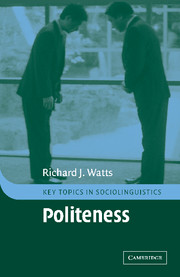Book contents
- Frontmatter
- Contents
- Preface
- 1 Introducing linguistic politeness
- 2 Politeness through time and across cultures
- 3 Modelling linguistic politeness (I)
- 4 Modelling linguistic politeness (II): Brown and Levinson and their critics
- 5 Facework and linguistic politeness
- 6 A social model of politeness
- 7 Structures of linguistic politeness
- 8 Relevance Theory and concepts of power
- 9 Politic behaviour and politeness in discourse
- 10 Politic behaviour and politeness within a theory of social practice
- Notes
- Glossary of terms
- References
- Index
4 - Modelling linguistic politeness (II): Brown and Levinson and their critics
Published online by Cambridge University Press: 24 November 2009
- Frontmatter
- Contents
- Preface
- 1 Introducing linguistic politeness
- 2 Politeness through time and across cultures
- 3 Modelling linguistic politeness (I)
- 4 Modelling linguistic politeness (II): Brown and Levinson and their critics
- 5 Facework and linguistic politeness
- 6 A social model of politeness
- 7 Structures of linguistic politeness
- 8 Relevance Theory and concepts of power
- 9 Politic behaviour and politeness in discourse
- 10 Politic behaviour and politeness within a theory of social practice
- Notes
- Glossary of terms
- References
- Index
Summary
BROWN AND LEVINSON'S THEORY OF POLITENESS: POLITENESS AS THE MINIMISATION OF FACE-LOSS
Brown and Levinson's theory of linguistic politeness first appeared in 1978, although Penelope Brown had already published an article entitled ‘Women and politeness: a new perspective on language and society’ in Review in Anthropology in 1976. The theory is often referred to as the ‘face-saving’ theory of politeness, as it builds on – but, I shall argue, also significantly changes – Goffman's notion of face. Like Lakoff and Leech it also builds on the Gricean model of the Cooperative Principle.
In the spirit of Grice, Brown and Levinson posit a Model Person (MP) with the ability to rationalise from communicative goals to the optimal means of achieving those goals. In doing so, the MP has to assess the dangers of threatening other participants' (and hence her/his own) face and to choose the appropriate strategies in order to minimise any face threats that might be involved in carrying out the goal-directed activity. In contrast to Leech's model, therefore, Brown and Levinson's model can be seen as an attempt to formulate a theory of how individuals produce linguistic politeness, i.e. it is a production model.
Face in Brown and Levinson's model is a theoretical construct which they claim they have taken from the work of Erving Goffman. The MP, with the ability to rationalise from communicative goals to the optimal means of achieving those goals, seems to fit well with their redefinition of face, but it is questionable whether the phenomenon of politeness can be reduced to forms of rational means–goals behaviour.
- Type
- Chapter
- Information
- Politeness , pp. 85 - 116Publisher: Cambridge University PressPrint publication year: 2003
- 2
- Cited by

